What is Aposematism in Animals?
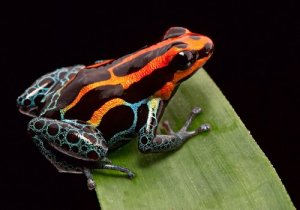
Aposematism is the bright coloration of animals. Usually, brightly colored animals have poisonous glands. Another method of aposematism in animals is through the emission of sounds, such as the audible warnings of a rattlesnake.
The word aposematism is composed of two Greet rooks: ‘apo‘, which means far or apart, and ‘sema‘, which means sign. Therefore, aposematism is the opposite of camouflage.
How aposematism in animals works
Aposematism in animals is almost always a defensive technique. It warns predators of potentially dangerous animals. However, for these warning signals to be effective, there must be prior knowledge on the part of the attacker as to what the visual or sound signal signifies. This knowledge is instinctive. That is, it is an inherited reaction learned from previous bad experiences.
Aposematism is an extremely effective method of defense. The animals count on these bright colors to warn potential predators and, for that reason, they don’t develop any other type of defense mechanism. Their coloring or sounds give off warnings without the animal needing to use any energy. Because of this, animals with aposematism have few predators.
However, there are exceptions. There are some species that have adapted to certain types of poisons.
Impersonating aposematism
Some non-poisonous animals adopt the appearance of animals with aposematism. This is known as mimicry, and is another kind of defense mechanism.
When they impersonate aposematism, these animals make predators believe that they are dangerous animals because of their brilliant color. However, in reality, they are harmless. One good example of this is false coral snakes. They share the same colors as the real ones, but the order of colors is different.

Aposematism is also present in some plants, although it is a rare phenomenon. Some plants that are relatively toxic have a bad taste or thorns, and this lets animals know they aren’t edible.
Some animals with aposematism
The most common and well-known aposematism species are wasps and bees. They have a pattern of rings of yellow and black colors that are clearly visible. These announce to all animals that they have a poisonous sting. As most people know, they don’t hesitate to use this sting when they feel in danger or that their hive is being attacked.
Caterpillars
Caterpillars also take advantage of their coloration to avoid being eaten by their natural predators. Because of this, there is a great variety of colors and shapes in all varieties of caterpillars. This is to warn of the presence of toxins.
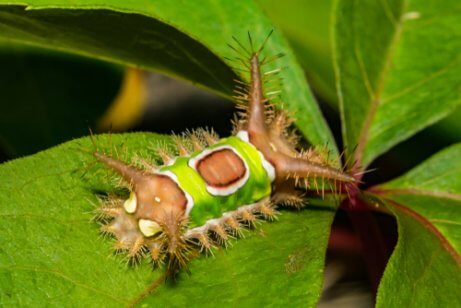
Poison dart frogs
Poison dart frogs, also known as poison arrow frogs (Dendrobatidae), is another example of an animal with aposematism. These frogs show that they are poisonous through their striking and bright coloration. They excrete an extremely poisonous substance through their skin. They live throughout Central and South America.
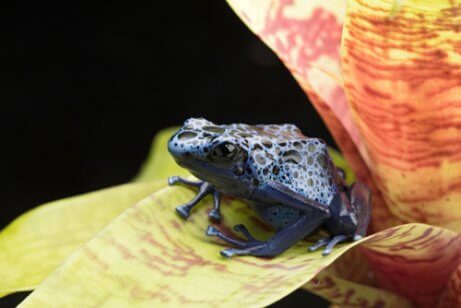
Coral snakes
Coral snakes are another example of aposematism in animals. These are a group of snakes with colorful rings that are extremely poisonous. The best known are those that have the following order of rings: red, black, and white. They inhabit tropical regions, both in the Western Hemisphere, with 73 species, and in the Eastern Hemisphere, with 16 species.
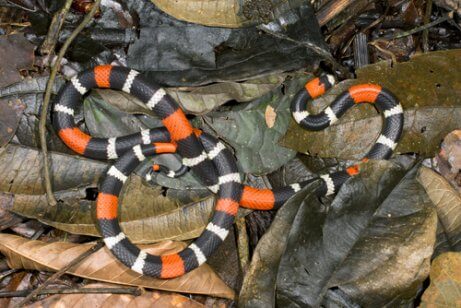
Lionfish
The lionfish (Pterois antennata) that lives in the Indian and Pacific Oceans is another animal with aposematism. They stand out for their striking red and white stripes. They also have a curious and threatening appearance.
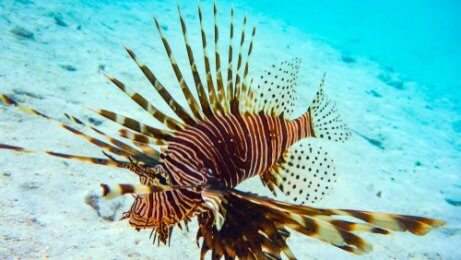
The spines that protrude from their dorsal fins have poisonous glands that contain a powerful venom capable of severely affecting large mammals.
Aposematism is the bright coloration of animals. Usually, brightly colored animals have poisonous glands. Another method of aposematism in animals is through the emission of sounds, such as the audible warnings of a rattlesnake.
The word aposematism is composed of two Greet rooks: ‘apo‘, which means far or apart, and ‘sema‘, which means sign. Therefore, aposematism is the opposite of camouflage.
How aposematism in animals works
Aposematism in animals is almost always a defensive technique. It warns predators of potentially dangerous animals. However, for these warning signals to be effective, there must be prior knowledge on the part of the attacker as to what the visual or sound signal signifies. This knowledge is instinctive. That is, it is an inherited reaction learned from previous bad experiences.
Aposematism is an extremely effective method of defense. The animals count on these bright colors to warn potential predators and, for that reason, they don’t develop any other type of defense mechanism. Their coloring or sounds give off warnings without the animal needing to use any energy. Because of this, animals with aposematism have few predators.
However, there are exceptions. There are some species that have adapted to certain types of poisons.
Impersonating aposematism
Some non-poisonous animals adopt the appearance of animals with aposematism. This is known as mimicry, and is another kind of defense mechanism.
When they impersonate aposematism, these animals make predators believe that they are dangerous animals because of their brilliant color. However, in reality, they are harmless. One good example of this is false coral snakes. They share the same colors as the real ones, but the order of colors is different.

Aposematism is also present in some plants, although it is a rare phenomenon. Some plants that are relatively toxic have a bad taste or thorns, and this lets animals know they aren’t edible.
Some animals with aposematism
The most common and well-known aposematism species are wasps and bees. They have a pattern of rings of yellow and black colors that are clearly visible. These announce to all animals that they have a poisonous sting. As most people know, they don’t hesitate to use this sting when they feel in danger or that their hive is being attacked.
Caterpillars
Caterpillars also take advantage of their coloration to avoid being eaten by their natural predators. Because of this, there is a great variety of colors and shapes in all varieties of caterpillars. This is to warn of the presence of toxins.

Poison dart frogs
Poison dart frogs, also known as poison arrow frogs (Dendrobatidae), is another example of an animal with aposematism. These frogs show that they are poisonous through their striking and bright coloration. They excrete an extremely poisonous substance through their skin. They live throughout Central and South America.

Coral snakes
Coral snakes are another example of aposematism in animals. These are a group of snakes with colorful rings that are extremely poisonous. The best known are those that have the following order of rings: red, black, and white. They inhabit tropical regions, both in the Western Hemisphere, with 73 species, and in the Eastern Hemisphere, with 16 species.

Lionfish
The lionfish (Pterois antennata) that lives in the Indian and Pacific Oceans is another animal with aposematism. They stand out for their striking red and white stripes. They also have a curious and threatening appearance.

The spines that protrude from their dorsal fins have poisonous glands that contain a powerful venom capable of severely affecting large mammals.
All cited sources were thoroughly reviewed by our team to ensure their quality, reliability, currency, and validity. The bibliography of this article was considered reliable and of academic or scientific accuracy.
Mappes, J.; Marples, N. & J. Endler (2005). “The complex business of survival by aposematism”. Trends in Ecology & Evolution, Vol. 20, N° 11: 598-603.
This text is provided for informational purposes only and does not replace consultation with a professional. If in doubt, consult your specialist.








